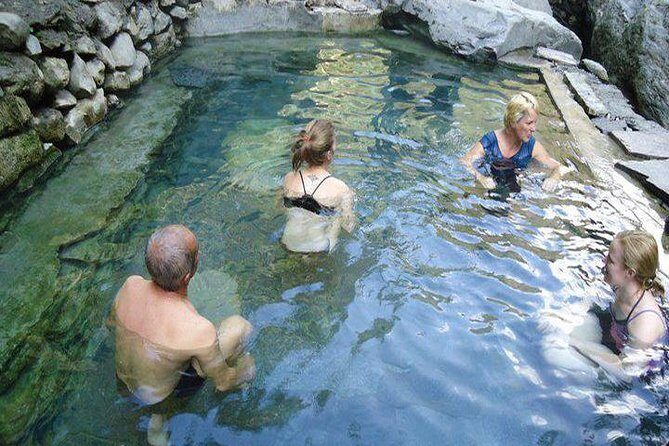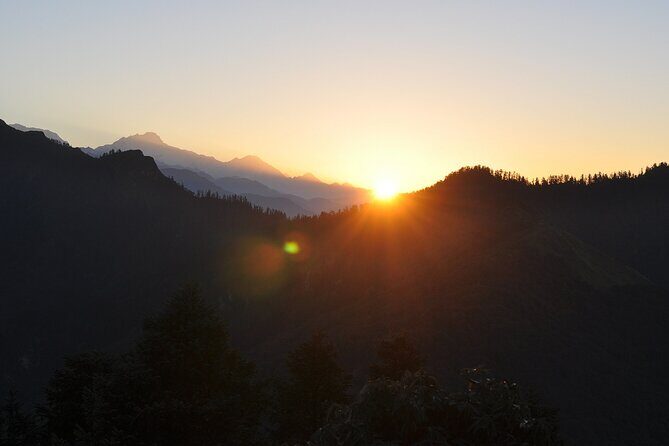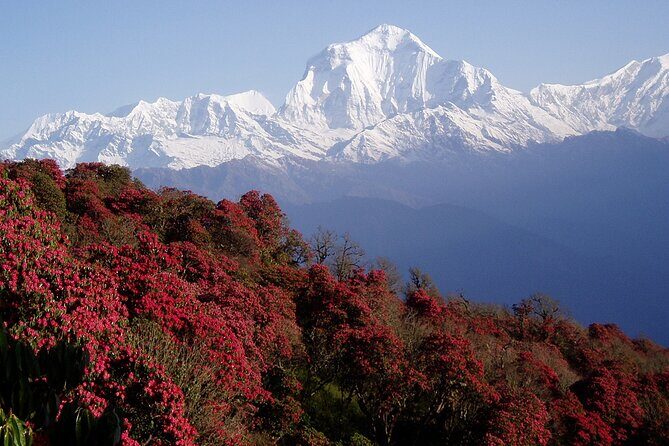Physical Address
304 North Cardinal St.
Dorchester Center, MA 02124
Physical Address
304 North Cardinal St.
Dorchester Center, MA 02124

Discover Nepal's shortest trek through the Annapurna region with hot springs, mountain views, and authentic villages—perfect for a quick adventure.
If you’re dreaming of a trek that combines scenic mountain vistas with relaxing hot springs but worry about time constraints, the Natural Hot Spring Trek from Kathmandu might just be your ideal escape. This 9-day journey offers a taste of Nepal’s stunning Annapurna region, including peaceful villages, lush forests, and, of course, the legendary hot springs believed to heal and relax.
What really draws us to this trek is its short duration combined with authentic experiences — it’s perfect for travelers with limited time yet still eager for a meaningful trek. We love that it offers a good mix of nature, culture, and wellness without requiring weeks of hiking. Still, it’s worth noting that the trek involves some steep sections, so a moderate level of fitness helps.
This tour is best suited for those who want a manageable trek with a focus on scenic beauty and local immersion. If you’re after a quick but fulfilling Nepal adventure that includes the allure of natural thermal baths, this could be a great fit. However, if you’re craving high-altitude mountaineering or extensive trekking, you might prefer more rigorous options.

You might also be interested in these Kathmandu experiences

Your adventure begins with a pick-up at Tribhuvan International Airport, a simple but thoughtful touch that sets a welcoming tone. After settling into a comfortable 3-star hotel in Kathmandu, you’ll head to Pokhara on a tourist bus the next day. The drive offers a change of scenery from bustling city streets to Nepal’s more relaxed lakeside vibe.
The overnight stay in Pokhara is a good chance to soak in the mountain views and prepare mentally for the trek ahead. The flexibility of a bed and breakfast basis here adds some simplicity and comfort without unnecessary fuss.
On Day 3, you transfer to Nayapul by car or van—about an hour’s ride. From here, the trek officially kicks off with a walk along the bank of the Burunde River, passing through charming villages like Hile and Tikhedhunga.
The highlight of this section is the climb to Ulleri, a village in the Myagdi District. It’s a steep ascent, taking roughly 2 hours, which can be challenging but rewarding with views of terraced fields and traditional houses. We appreciated that the trek uses tea houses for overnight stays — a chance to connect with local culture and enjoy simple, hearty meals.
Day 4’s walk through dense forests of rhododendron and oak is a highlight, especially if you’re traveling in spring when these flowers bloom in vibrant reds and pinks. The trek to Ghorepani is relatively gentle but becomes more scenic as you approach higher elevations.
The early wake-up call on Day 5 to hike to Poonhill for sunrise is a popular feature of this trek. At 3,210 meters, the viewpoint offers panoramic vistas of mountain giants like Dhaulagiri, Annapurna, and the Fishtail. We found that the early morning effort is worth it, as the sunrise over snow-capped peaks is truly breathtaking.
Descending back to Ghorepani and then trekking down through Chitre Village to Sikha allows you to witness local village life and perhaps meet some friendly villagers along the way.
Outdoor enthusiasts can explore more Kathmandu trails with these hiking options
On Day 6, after a roughly 4-hour descent, you arrive at Tatopani, famous for its natural hot springs. The hot water baths are the centerpiece of this day, offering a relaxing soak in mineral-rich waters believed to cure skin ailments and reduce stress.
Multiple travelers have commented that the hot spring bath is a must-do experience that genuinely feels restorative after days of trekking. It’s also an opportunity to socialize with fellow travelers and locals, creating a sense of shared wellness.
After soaking in the hot springs, you’ll head back to Pokhara via local Jeep or bus — a scenic drive that passes through lush forests and mountain views. In Pokhara, you’ll enjoy another overnight stay, giving you a bit of time to explore or relax.
The final leg takes you back to Kathmandu by tourist bus. The trip concludes with a Nepali cultural dinner and a show — a fitting way to end your adventure with traditional music and dance.

The itinerary’s balance of trekking, culture, and relaxation makes this tour feel well-rounded. The inclusion of hot springs adds a special wellness dimension that many travelers find memorable. The hot spring fee is included, which saves you from extra costs and the surprise of finding that perfect soak.
The transportation arrangements — including private transfers, tourist buses, and local jeeps — are practical and ensure smooth travel between locations. The accommodations are mostly in comfortable tea houses and 3-star hotels, providing a cozy retreat after a day’s trek.
While the trek isn’t overly demanding, some steep climbs and descents require a decent level of fitness, especially given the 2-hour steep climb to Ulleri and the ascent to Poonhill. Travelers with mobility issues or very low stamina might find certain sections challenging.
Plus, the price of $752 seems reasonable considering the inclusions, but keep in mind that airfare, Nepal visa fees, and personal expenses are not included. Also, the group size isn’t specified, so if you prefer a more intimate experience, it’s worth clarifying with the provider.
One reviewer mentioned that the guides are knowledgeable and friendly, often sharing local stories and cultural insights. They also highlighted that the hot spring bath feels genuinely healing after days of walking, confirming its role as a highlight.
Another traveler appreciated that the meals at tea houses are simple but filling, giving a taste of local cuisine. They also noted that the timing of the sunrise at Poonhill is perfect for photography, so don’t forget your camera.
At $752 per person, the tour offers a lot of what travelers seek: transportation, guided trekking, permits, hot spring fee, accommodations, and some meals. This makes it an excellent value for those wanting a guided experience that handles logistics. The inclusion of hot springs—a feature often added as an optional extra—is especially appealing.
However, travelers should consider their own travel costs (like flights and visas) and personal expenses, as these are not included. The flexibility of a private tour means you won’t be part of a large group, which can enhance comfort and flexibility.
This trek is ideal for busy travelers or those new to trekking who want a manageable adventure with authentic Nepalese experiences. It’s especially suited for nature lovers, wellness seekers, and culture enthusiasts who don’t want to spend weeks in the mountains but still crave memorable vistas and local interaction.
If you’re looking for a relaxing, scenic trek with a wellness twist, this tour ticks those boxes. But if you prefer high-altitude challenges or longer, more remote treks, you might want to look elsewhere.
Do I need trekking experience to join this tour? While it’s designed to be accessible, some steep climbs are involved. A moderate fitness level will make the experience more enjoyable, but beginners with some hiking experience should be fine.
Are meals included during the trek? Not all meals are included, but the tour provides breakfasts on all days and lunches/dinners on some days. Meals at tea houses are simple yet hearty.
Is transportation provided between Kathmandu, Pokhara, and the trekking start/end points? Yes, the tour covers Kathmandu to Pokhara and back, as well as transfers from Nayapul to trekking areas and Tatopani to Pokhara.
What about the hot springs fee? The fee for bathing in the hot springs is included in the tour price, so there are no extra charges for this relaxing experience.
How difficult is the trek? It’s generally considered moderate with some steep sections, suitable for most travelers with average fitness.
What is the group size? The tour is private, so only your group will participate, enhancing comfort and flexibility.
The Natural Hot Spring Trek from Kathmandu offers a thoughtfully curated experience for anyone wanting a taste of Nepal’s beauty without dedicating weeks to higher-altitude challenges. It’s a blend of spectacular mountain views, cultural exposure, and wellness in a manageable format.
For travelers eager to unwind in healing mineral waters, explore charming villages, and witness sunrise over Himalayan giants, this trek provides a well-rounded experience. Its inclusive approach, comfort, and authentic touches make it a compelling choice—especially for those balancing adventure with relaxation.
If you’re after a short, scenic journey that combines the best of Nepal’s natural and cultural treasures, this trip deserves serious consideration. It’s a chance to tick off mountain views, warm springs, and local villages—all in less than two weeks.